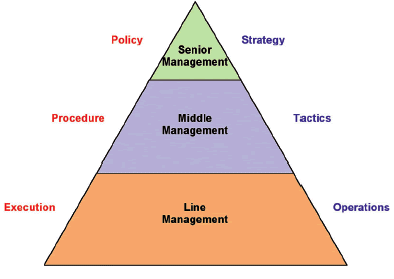When an organisation embarks on a change project it is normally for a reason. It may be a reaction to a problem, new management initiative, technical changes, organisational changes, competition etc. Whatever the reason one thing is certain: change is never easy.
If one of the aims of a change programme is to improve process performance within the organisation, then we will need to encourage everyone to take a fresh look at what they do, how they do it and how it might be improved.
At the start of a new initiative, it is often assumed that the middle managers will somehow automatically jump on board and support the proposals of senior management. However experience shows us that this cannot be relied upon. In reality senior management have to win over the management team and key staff. Failure to do this at the early stages can make the changes more problematic.
Why is middle management so important?
Middle managers play a crucial role in implementing the policies and strategies set down by senior management. They ensure that all the required activities to complete the process, satisfy the customer, comply with regulations or legislation and meet the organisation's objectives are carried out.
Middle management performs a pivotal role in the integration of knowledge and experience, within a given strategic framework to generate practical applications. They are responsible for finding ways of dealing with and alleviating the impacts of problems as they occur, whilst managing employees to ensure that they are well-motivated and act responsibly.
They also form the central point of communication, positioned between the senior management and the general staff. As part of planning and implementing corporate strategy, they need to communicate with employees to ensure these strategies are interpreted and related to the individual so that they can carry out the appropriate tasks.
Equally they will be expected to report back to senior management on how business is progressing, the impact of any new initiatives and any issues raised that may impact the corporate vision.
They are already key players in the day-to-day smooth running of the operation. It makes sense that they are also an essential element in any change that will affect how the organisation operates.

Catalysts for change or mechanism of mayhem?
Middle managers are the key influencers within any organisation. Not only do they have a great deal of experience within the organisation, they are also the ones making things happen. They are the planners, directing the staff to do the right things at the right time.
For any change programme to succeed it is absolutely essential that middle managers support the changes and are actively engaged in the project. But remember, this influence can be either very positive or negative depending on experiences from the past and also the type of individuals they are. So when it comes to implementing process improvement programmes, their performance will determine whether the change initiative is a success or a failure.
In organisations where the middle management team is performing well, it is normally an indicator that they are not only monitoring performance and generating the right change initiatives but also they are able to constantly adapt and improve their strategy during implementation. When change is actively managed in a positive environment, then everyone is encouraged and motivated to embrace change and contribute ideas.
On the other hand, where the middle management team is performing poorly, change becomes increasingly difficult to achieve. Any issues are seen as showstoppers and reasons to turn back to the comfort of the old ways. In this environment the pace of change itself can slow down or even stop.
Potential barriers to change
Whenever a new initiative is proposed, one of the most common objections raised is that there are never enough resources available. The day-to-day activities still need to be supported, while staff need to be released to work on the change programme.
As part of best business practice, one of the objectives of middle management should be continuous process improvement, so there should be an element of this work in the day-to-day activities.
If process improvement is important to the organisation, then this should be reflected in how successful improvements and progress are recognised and rewarded. The nature of the reward should reflect the culture of the organisation and what motivates the individuals concerned.
Many middle managers believe that their in-depth knowledge and expertise in operating the current practices forms part of their authority. Change however represents uncertainty and will require them to step outside their comfort zone.
Most people prefer to stay with what they know and continue to work as they always have as it is familiar to them and part of their routine. They may think that staying with what they know takes less effort and makes the day-to-day activities run more smoothly. Individuals are not always aware of how inefficient their current way of working might be.
In order to engage middle managers in improving process performance, they need to embrace the idea of change. The more that change becomes part of the everyday activity, the more the culture of the organisation becomes associated and accepting of change. For middle managers, this not only means guiding and supporting their staff during change, but also adapting to change themselves.
Measure the effects of change
We have mentioned above that in order to commit to any process improvement or change programme, middle managers need to see that it is of benefit to them. Change is only welcomed if it makes life easier, reduces costs or adds value that is in line with the goals and objectives against which management will be assessed.
In order to assess the benefit of change or how much you have improved the process, you must be measuring the activity. You need to establish a benchmark of where things are currently, so that you have a reference point to evaluate the correlation between cause and effect. The measurements to be used need to be representative of the activity being monitored, unambiguous, quantifiable and repeatable. They must also be acceptable to the managers.
Measurements need to be taken at regular intervals during the project to assess the impact of changes made. You do not want to go too far along the path before realising that the result has been detrimental! Also if you allow too many changes to be made without monitoring the effect, you will not have a clear picture of which changes worked and which didn't. Regular measurement of the benefits also means that you have evidence to communicate to everyone involved in the project to encourage continued improvements.
The importance of communication
Communication is a key factor in all change projects. In order to maintain the momentum of improving process performance it is important to provide regular feedback on what progress is made. If everyone sees the results that are being achieved, they are more likely to continue to move in the direction you want.
Many teams today are literally multicultural, but even if everyone is from the same country, they still have their own background, experiences, style and personal preferences. There is no 'one size fits all'. Different people think differently, communicate differently and respond to different stimuli.
When communicating to a group you need to appeal to as many senses as possible to catch the preferences of your audience. Use a variety of communication techniques e.g. visual presentations, reports, meetings etc. Don’t assume that what works for you works for others too.
Conclusions
Middle managers are the potential problem in a change project but they are also the potential solution. They hold valuable information about current practices and potential for improving the process performance within the organisation. With the right approach they can become true 'ambassadors' for change and encourage junior staff to contribute to the programme.
Extracted from a presentation given at the 2006 ESEPG Conference in Amsterdam.












